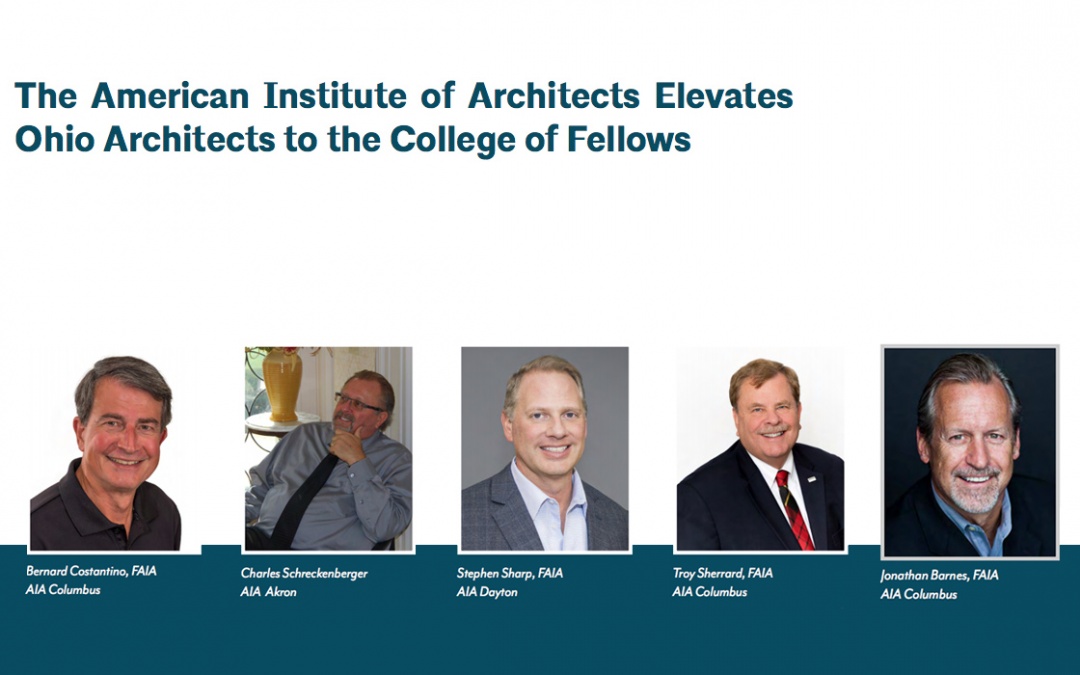
The American Institute of Architects Elevates Ohio Architects to the College of Fellows
AIA Fellowship Recognizes Significant Contributions to the Profession of Architecture and Society
The 2018 Jury of Fellows of the American Institute of Architects elevated five AIA Ohio members to its prestigious College of Fellows, an honor awarded to members who have made significant contributions to the profession. This year 152 AIA members were elevated and will be honored at an investiture ceremony at the AIA Conference on Architecture in New York City. The Fellowship program was developed to elevate those architects who have made a significant contribution to architecture and society and who have achieved a standard of excellence in the profession. Out of a total AIA membership of over 91,000, less than 4 percent are distinguished with this honor. Election to fellowship not only recognizes the achievements of architects as individuals, but also their significant contribution to architecture and society on a national level.

AIA Ohio President’s Message, May Newsletter
 Participation on the AIA Ohio Board provides a unique opportunity to connect with architects in leadership positions across the country. Most recently, the AIA Grassroots event in San Diego provided such a platform to listen to, and share ideas with, architects who are making a difference in their cities by helping to guide social, environmental, and economic policy. A clear theme was the need for architects to “find a seat at the local table” as a way of exerting influence. As design thinkers, we are well equipped to help solve these types of complex civic problems; we just need to make it happen. In Ohio, we should all think about how we might personally join these conversations, or how we might better encourage our staffs to do so. In the words of Grassroots speaker and former California mayor Liz Gibbons, AIA, “if you aren’t at the table, you’re on the table.”
Participation on the AIA Ohio Board provides a unique opportunity to connect with architects in leadership positions across the country. Most recently, the AIA Grassroots event in San Diego provided such a platform to listen to, and share ideas with, architects who are making a difference in their cities by helping to guide social, environmental, and economic policy. A clear theme was the need for architects to “find a seat at the local table” as a way of exerting influence. As design thinkers, we are well equipped to help solve these types of complex civic problems; we just need to make it happen. In Ohio, we should all think about how we might personally join these conversations, or how we might better encourage our staffs to do so. In the words of Grassroots speaker and former California mayor Liz Gibbons, AIA, “if you aren’t at the table, you’re on the table.”
In Ohio, we’re taking our Board meetings on the road this year. In March, we met at Bowling Green’s new facility for the Department of Architecture & Environmental Design. AIAS Presidents from Ohio’s five Schools of Architecture joined the meeting and discussed what’s happening at their respective school, how millennial architects see their futures, and the role AIA Ohio might play to better connect with this group. A priority for our future architects–something I hear over and over and that was the topic of an Emerging Professionals event in Cincinnati just recently–is the desire to make a difference in the world, to practice an architecture that is relevant. All of which bodes well for our professional future. Following the meeting, the Board spoke with BGSU Architecture students on these same topics – offering a lively and hopefully valuable session. A big thanks to BGSU for hosting, and to the AIAS student leaders from around the state for taking the time to join us.
In May, NBBJ hosted our Board meeting in Columbus. By moving our meetings out into the architectural community, this should not only provide an opportunity to learn more about our Ohio firms but also make the activities of our Board more visible. A focus for our May meeting was how we promote architects and architecture to our membership but also to the public. Newly retained consultant MJ2 Marketing attended and engaged the Board in discussions about how we might improve our PR/marketing efforts, and how we might better align these efforts at local, state, and national levels. Stay tuned!
John Weigand, AIA

Emerging Architectural Design Trends
As technology evolves at an exponential rate and end-user demands continue to change with the times, the architectural industry naturally responds by providing innovative design year after year. Watch for these emerging design trends to transform our communities in the coming year.

Call for Entries: AIA Ohio Design Awards
Are you especially proud of one of the projects your firm designed last year? AIA Ohio is now seeking entries for the 2018 AIA Ohio Design Awards. read more…

Welcome to the New and Improved AIA Ohio
AIA Ohio is going big and bold in 2018, starting with a focus on getting more active and involved with our communities through our social networks. We have always been an active voice for the profession and served as the authoritative source for information on the built environment, and now we’re ramping up our social and content marketing to match.
OFCC Approves Grant Template for Charter Schools Program
The Ohio School Facilities Commission approved a template grant agreement Thursday for the upcoming award of grants for high-performing charter schools.
Created in biennial budget bill HB64 (R. Smith), the grant program can reimburse eligible schools for projects that increase seats in effective schools, serve unmet needs and show innovation. The commission previously approved guidelines governing the grant program.
Jeff Westhoven, chief of facility and program services for the commission, said staff used a template developed for cultural facilities projects two years ago as a starting point.
The program requires a 50 percent local match and a covenant to ensure buildings constructed or modified under the program must be dedicated to education purposes for at least 10 years following completion of the project. The template agreement spells out potential remedies for cases in which a school breaks that covenant, such as by becoming insolvent.
Westhoven said he anticipates applications opening for a 90-day period starting some time in March, with final approval of grants by the Controlling Board around October or November.
Rep. Dan Ramos (D-Lorain) asked what power the commission would have to encourage a building owner to find a new tenant quickly if the original school moved or closed. Westhoven said it would be in the business interest of the owner to secure a new school as a tenant, because the covenant would restrict leasing the building to anyone else. Ramos responded by noting gas stations and grocery stores will sometimes move without breaking their leases to ensure competitors can’t occupy their former premises. “Capitalism can move both ways. Something to consider,” he said.
During his report, the new executive director of the OSFC and Ohio Facilities Construction Commission (OFCC), David Williamson, said the commissions have begun a strategic planning process. Division chiefs identified a total of 158 tasks needed to achieve future goals and improve the level of service provided by the commissions, then staff worked to align that to a plan across three budget cycles. The plan is still being finalized, he said.
U.S. Housing Secretary Announces Insurance Rate Cuts to Spur Multifamily Housing Units
Julian Castro, U.S. Housing and Urban Development secretary, said he chose Columbus, Ohio to make a national announcement Thursday because of its exemplary development in the push for affordable housing.
Castro announced the Federal Housing Administration (FHA) is lowering insurance rates it charges on mortgages for multifamily rental housing properties, effective April 1, 2016. Speaking Thursday at the recently completed Poindexter Place senior housing development on Columbus’ Near East Side, Castro said the rates are being lowered nationally to incentivize more affordable housing development, preserve existing housing units, and encourage energy-efficient homes.
“We chose Columbus because this is a fantastic community that’s being developed, and it’s a good example of all of the pieces of what we do coming together, with the Choice Neighborhood initiative, as well as multifamily development,” Castro said Columbus received nearly $30 million to revitalize the Poindexter Village through HUD’s Choice Neighborhood grant program in 2014.
“At its essence, what we’re doing today is a case of ‘less is more,'” Castro said. “Less borrowing costs mean more capital to rehabilitate affordable housing, more investment in energy-efficient upgrades that benefit more people and our environment, more construction and rehabilitation projects which will spark economic activity across the board in communities throughout the United States, and including here in Columbus.
“And as important as anything, it means that more Americans will have a safe, decent place to call home.”
Castro said the multifamily rate reductions “will allow affordable rental projects to support approximately 4 percent more debt. We estimate that this will help rehabilitate nearly 40,000 units over the next three years. Developers can also use these dollars to build more housing or even to cut existing rent for families. They can also increase energy efficiency and cut greenhouse gas emissions.”
The new insurance rates include three housing categories: “Broadly Affordable” housing, where at least 90 percent of units are under Section 8 or the Low Income Housing Tax Credit; mixed-income properties, including a partial percentage of affordable housing; and energy-efficient properties.
Julie DeGraaf Velasquez, senior vice president of McCormack Baron Salazar, the site developer of Poindexter Village, said Thursday the secretary’s announcement “means that we’ll be able to stretch our first mortgage financing even further, allowing us to serve more families at a time of limited resources and growing need for affordable and sustainable housing.”
Castro also said that HUD has a “strong role” to play in President Barack Obama’s Climate Action Plan.
“This is our way of both trying to spur more preservation of affordable units and create more, and then also incentivize the private sector to go green,” he said.
HUD estimates almost 50 percent of renter households spent more than 30 percent of their income on housing in 2014, with more than a quarter of renters spending half their income on a place to live.
“No matter where I go, what I hear from folks is that they’re having to spend more money on the rent, and that folks have a problem oftentimes finding something that is affordable,” Castro said. “That means more people are spending a lot more of their budget on the rent than they ought to be; they’re doubling up, they’re not enjoying as good a quality of life as they could because the rents are so high.”
He said the new rates are good policy and also helpful for FHA business, during a time the housing administration has a strong multifamily portfolio. He projected continued generation of positive returns to the federal government. The rate reduction will give all stakeholders more chances to work together and invest in development that welcomes families of all income levels, he said.
Also in attendance, Columbus Mayor Andrew Ginther said affordable housing is “critical” to stabilizing and improving quality of life in neighborhoods. He noted in his tenure, he will be primarily focused on the Near East Side and South Side of the capital city, as well as Linden and The Hilltop neighborhoods. He said the rate reductions will have a large impact on Columbus, and that Ohio should be a part of HUD’s announced energy-efficient housing plans.
“We need to be assuming a leadership role in helping to make sure that safe, affordable housing isn’t just necessarily having a roof over your head but [about] the sustainability involved with it, particularly as energy prices continue to go up,” Ginther told Hannah.
Castro also made note of his time as mayor of San Antonio, TX.
“As a former mayor, I know that you need a city that works and is affordable for everybody to have a good quality of life, so it only makes sense to incentivize affordable housing development.”
BBS Issues Memos for Tank Regulation and Generator Installations
The Board of Building Standards has issued two new BBS Memos regarding the regulation of tanks and the installation of generators. Question can be directed to the Board’s technical staff at 614-644-2613.
Architects CE Bill Passes House
The Ohio Architects Board is sponsoring HB243, which has been endorsed by AIA Ohio and would modify Board authority to revise the types of activities that qualify for continuing education credits. The bill passed the House unanimously December 8 and now will be considered by the Senate. Although the Board has no plans for immediate changes to its CE requirements, it believes that HB 243 is needed to clarify the issue in light of the Legislative Service Commission’s contention that the Landscape Architects Board, which operates under identical statutory authority, didn’t have the ability to change the types of activities that qualify for CE.
Commerce Department’s David Williamson to Lead Facilities Commission
David Williamson, superintendent of the Division of Industrial Compliance at the Ohio Department of Commerce, will take over next week as executive director of the Ohio Facilities Construction Commission (OFCC) and its subsidiary agency, the Ohio School Facilities Commission.
The OFCC voted 3-0 Wednesday to appoint Williamson to the job, effective Nov. 8, at a salary of $115,000 per year, following an executive session to discuss personnel matters. Budget Director Tim Keen, who chairs the commission and led the search process, said he was impressed by Williamson’s knowledge of state government and organizational leadership.
Williamson has had two stints as superintendent of the division, during the Kasich administration and from 1999 to 2007 in the Taft administration. He previously served as executive director of the Board of Cosmetology and retired as a colonel from the U.S. Air Force after 28 years of service.
The work of Williamson’s division at the Department of Commerce is related to that of the facilities commission, as it oversees building codes and construction industry licensing.
Keen and his fellow cabinet officers on the commission — Administrative Services Director Robert Blair and Rehabilitation and Correction Director Gary Mohr — offered gratitude to David Chovan, a senior staff member who has served as interim executive director following the October 2014 retirement of former Executive Director Richard Hickman. They also thanked the rest of the staff for their efforts during the transition.
Kent State’s May 4 Visitors Center Receives Historic Preservation Certificate
Kent State University’s (KSU) May 4 Visitors Center has been selected by the International Society for Landscape, Place and Material Culture (ISLPMC) to receive its Historic Preservation Certificate of Merit. This award is given yearly to select individuals and organizations engaged in activities designed to preserve historical sites and raise public awareness of preservation efforts.
The award was presented to the center’s director, Mindy Farmer, at the society’s 2015 conference in North Canton. Farmer attributes the award selection to the May 4 Visitors Center’s passion for preservation of the physical site, as well as its focus on educating the public about the events of May 4 and their lasting impact.
“This award acknowledges both our proficiency in interpreting a difficult, confusing event and our commitment to preserving the site and its history,” Farmer said. “May 4, 1970, was a traumatic day for this campus, the nation and the world. Yet, the May 4 Visitors Center is a place of healing. With great care, we provide an honest account of an event that might be easier to ignore and we talk openly about tough topics that might be easier to avoid.”
Farmer described the honor as humbling.
The May 4 Visitors Center offers an educational walking tour to anyone interested in learning more about the historical significance of the May 4 events. The tour includes stops at locations where key moments took place. “This blending of physical space with educational materials is part of what makes the center such a unique and memorable experience,” the center said in a release.
Farmer cites the center’s commitment to education as an important aspect of its success.
“We are committed to the academic study of May 4, 1970, and its legacy so that every time a student, alumnus or visitor is asked about that fateful day, they have a thoughtful, evidence-based answer,” Farmer said. “In this way, the center serves as a powerful reminder that Kent State University is willing to learn from the past, however difficult, to shape the future.”
More information about Kent State’s May 4 Visitors Center can be found online at www.kent.edu/may4.
